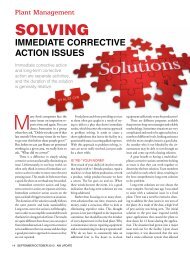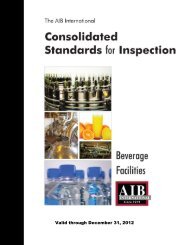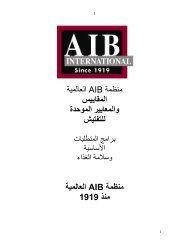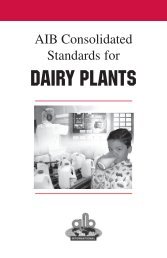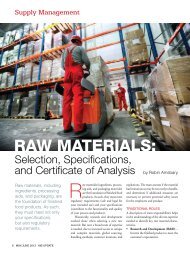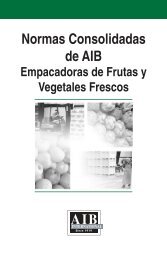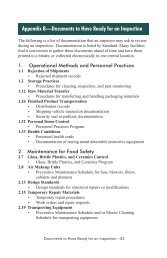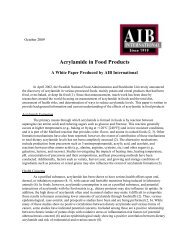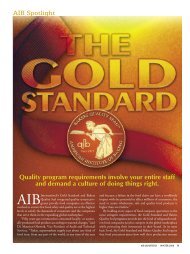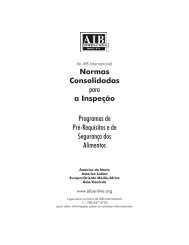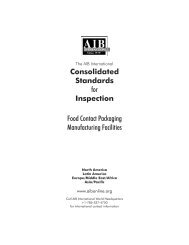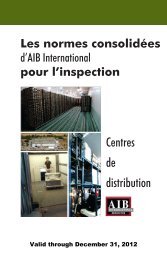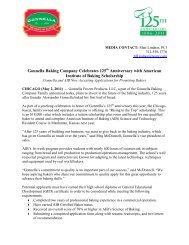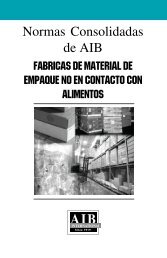Consolidated Standards for Inspection Food Distribution Centers
Consolidated Standards for Inspection Food Distribution Centers
Consolidated Standards for Inspection Food Distribution Centers
You also want an ePaper? Increase the reach of your titles
YUMPU automatically turns print PDFs into web optimized ePapers that Google loves.
• Maintenance—Cleaning that requires specialized<br />
assistance from skilled maintenance personnel to<br />
remove food residues, maintenance chemicals, <strong>for</strong>eign<br />
material, or contamination resulting from maintenance<br />
activities.<br />
• Personnel Areas—Cleaning of bathrooms, locker<br />
rooms, break areas, or other similar areas.<br />
Certifi cate of Analysis (COA)—A document containing<br />
test results that are provided to the customer by the<br />
supplier to demonstrate that product meets the defi ned<br />
test parameters, and complies with the ingredient<br />
specifi cations.<br />
Chemical Safety Data Sheet (CSDS)—A document<br />
designed to provide workers and emergency personnel<br />
with the proper procedures <strong>for</strong> working with or handling<br />
a chemical substance. The CSDS provides in<strong>for</strong>mation<br />
such as physical and chemical data, toxicity, health effects,<br />
emergency and fi rst aid procedures, storage, disposal,<br />
protective equipment requirements, routes of exposure,<br />
control measures, precautions <strong>for</strong> safe handling and use,<br />
and spill/leak procedures.<br />
Competency—A range of skill, knowledge, or ability.<br />
Contamination—The act or process of making something<br />
harmful or unsuitable. The presence of extraneous,<br />
especially infectious, material that renders a substance or<br />
preparation impure or harmful.<br />
Corrective Action—A change implemented to address an<br />
identifi ed weakness.<br />
Critical Control Points (CCPs)—A point, step, or<br />
procedure at which controls can be applied, and a food<br />
safety hazard can be prevented, eliminated, or reduced to<br />
an acceptable level.<br />
Customs-Trade Partnership Against Terrorism<br />
(C-TPAT)—A voluntary supply chain security program<br />
led by U.S. Customs and Border Protection (CBP) and<br />
focused on improving the security of private companies’<br />
supply chains with respect to terrorism.<br />
Defect Action Levels (DALs)—The levels of natural or<br />
unavoidable defects in foods that present no health hazards<br />
<strong>for</strong> humans.<br />
Defl ector Plate—An angled piece of metal or plastic with a<br />
lip on either side that is placed under a bearing or gearbox<br />
to divert lubrication or other leakage away from the<br />
product or food contact surface to prevent contamination.<br />
Environmental Protection Agency (EPA)—This is the<br />
US government agency that is tasked with developing and<br />
en<strong>for</strong>cing regulations that implement environmental laws<br />
enacted by Congress. This includes, but is not limited to,<br />
regulations such as: pesticide laws and registration, The<br />
Clean Water Act, and drinking water requirements.<br />
Essential Glass—Glass in a facility that is unavoidable or<br />
that cannot be replaced with another material.<br />
36—Glossary<br />
Findings—Notes made by an inspector that are indexed to<br />
a Standard or related requirement. There may be multiple<br />
fi ndings in an observation.<br />
Floor/Wall Junction—The point at which the fl oor and<br />
wall meet.<br />
<strong>Food</strong> Facility—Any facility that manufactures, processes,<br />
packs, or holds food <strong>for</strong> human consumption.<br />
<strong>Food</strong> Grade—A material or product that will not transfer<br />
nonfood chemicals into the food and contains no chemicals<br />
that would be hazardous to human health.<br />
<strong>Food</strong> Safety Modernization Act (FSMA)—The act signed<br />
into law on January 4, 2011 that aims to ensure the safety<br />
of the United States food supply is safe by shifting the<br />
focus from responding to contamination to preventing it.<br />
Foreign Supplier Verifi cation Program—The import<br />
requirement of FSMA that deals with verifi cation of the<br />
safety of food offered <strong>for</strong> import into the United States.<br />
Importers that fail to comply with this program are<br />
prohibited from importing food into the United States.<br />
Genetically Modifi ed Organism (GMO)—This is an<br />
organism whose genetic material has been altered using<br />
genetic engineering techniques.<br />
Global <strong>Food</strong> Safety Initiative (GFSI)—GFSI is the<br />
organization/technical committee that has established the<br />
criteria against which to benchmark certifi cation standards.<br />
The criteria are also used to benchmark food safety<br />
management schemes.<br />
Good Manufacturing Practice (GMP)—A food<br />
manufacturing practice that, when followed, protects food<br />
from contamination. Examples are defi ned in the U.S.<br />
21 CFR 110. Sometimes a “c” is placed in front of the<br />
abbreviation, GMP, to indicate that the practice is current.<br />
Hazard Analysis Critical Control Point Program<br />
(HACCP)—The 7 step process used to identify, eliminate,<br />
or reduce to an acceptable level any physical, chemical,<br />
or microbial hazards identifi ed in the ingredients, process,<br />
or product being manufactured. HACCP is based on risk<br />
assessment, and identifi es the points within the process<br />
where controls may be put in place and monitored to<br />
control the identifi ed hazards.<br />
Hazard Analysis Risk-Based Preventive Controls<br />
(HARPC)—The analysis that identifi es a hazard and the<br />
preventive control <strong>for</strong> that hazard.<br />
Heating, Ventilation, and Air Conditioning (HVAC).<br />
High-Risk Operation—Operation that involves food at risk<br />
of contamination because it is processed and stored within<br />
temperature ranges from 40°F (4°C) to 140°F (60°C) in a<br />
non-sterile environment.<br />
Imminent—Likely to occur at any moment.<br />
Infestation—The presence of live or dead life cycle stages<br />
of insects in a host product, the evidence of insect presence,<br />
or the establishment of an active breeding population.



